
Features
Hot topics
Incident reports
Pre-plan thwarts disaster: N.B. flood management focuses on local responders
Oromocto, N.B. – Finding water to use for firefighting operations can often be a challenge for fire departments. But, on occasion, firefighters find they have more than they need. Flooding along the St. John River in New Brunswick is an annual spring occurrence but rarely causes any significant damage. Such was not the case this year, when heavy rains and warm temperatures all combined with a heavier-than-normal snowfall to cause the worst flooding since 1973.
July 18, 2008
By Andrew A. Sanojca
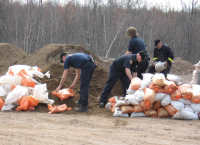
|
| Photo courtesy Oromocto Fire Department Oromocto firefighters help with sandbagging efforts to protect residential and commercial properties from the rising St. John River. |
Oromocto, N.B. – Finding water to use for firefighting operations can often be a challenge for fire departments. But, on occasion, firefighters find they have more than they need. Flooding along the St. John River in New Brunswick is an annual spring occurrence but rarely causes any significant damage. Such was not the case this year, when heavy rains and warm temperatures all combined with a heavier-than-normal snowfall to cause the worst flooding since 1973.
The St. John River runs 673 kilometres from north-central Maine to the city of Saint John, where it empties into the Bay of Fundy. It crosses into northern New Brunswick near Edmundston. Serious flooding had occurred along the river in 2005 and many lessons learned from that experience were put to use this year.
Andy Morton is the deputy director of the New Brunswick Emergency Measures Organization, and told Fire Fighting in Canada about his agency’s role with the emergency.
“It is the local response which is the most important aspect,” he said. “NB EMO provided assistance when local resources were insufficient, and monitored events throughout the river basin.
“Early on it was obvious that we had a lot of suspended water in the northern snow pack following a record setting winter. The only question that we had left was how fast it would melt out and would we get any heavy rain during the melt-out period when the river was already full. Without the rain, water levels would have exceeded flood stage in most areas but not to the same level of severity. Basically, we only realized how bad it would be when we were able to see how much rain fell, especially in the northwestern part of the basin.”
Once it was recognized in early March that flooding would occur, meetings were held with numerous fire departments in Fredericton and Oromocto and with other organizations to prepare them for the situation and encourage the development of detailed flood-response procedures, Morton said.
NB EMO also shared information on flood forecasting with all agencies involved. “Two major points that came out of spring 2005 were that local response is the key element to a successful operation, and, secondly, that public communication is vital to ensure that public safety messaging occurs in a timely fashion,” he said.
 |
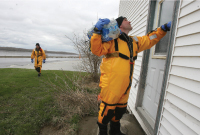 |
|
| Photo courtesy Oromocto Fire Department Pre-planning and co-ordination with other agencies helped the Oromocto fire department ensure an efficient response to flooding in May. |
Photo by Stephen MacGillivray, The Daily Gleaner Firefighters are seconded to deliver supplies to residents along the St. John River. |
|
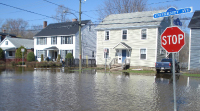 |
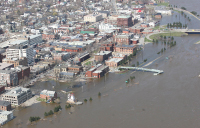 |
|
| Photo courtesy Tony Whalen Fredericton residents are familiar with the rising waters of the St. John River after flooding in 2003 and again this year.
|
Photo by The Daily Gleaner The swollen St. John River overtakes Fredericton. |
The Town of Oromocto Fire Department provides fire protection and rescue services to about 25,000 residents over 1,000 square kilometres. Besides the Town of Oromocto, the department also covers the unincorporated areas in the local service districts of Burton, Geary, Lincoln, Maugerville, Rusagonis-Wassis and Sheffield. Jody Price is the fire chief in Oromocto. He said the department worked after the 2005 flood with a local citizens’ group to be prepared, including, “surveying of the entire 105 Highway, which was the old Trans-Canada Highway, for occupants, farm animals and people with special needs, including the elderly and those on medications.”
The department also checked for hazardous materials and noted those locations. High- and low-water marks from previous events were recorded for reference. Speaking of all the work done then to prepare for the next flood, he said, “This aided us greatly in the ramp-up of this disaster emergency response from donuts to military barges used to evacuate cattle.”
Preparations for possible spring flooding began in January by the Oromocto department. The snow pack in the upper river basin area in northern Maine, southern Quebec and northern New Brunswick was above normal years with about 450 centimetres of snow compared to an average of about 300 centimetres. The Oromocto Fire Department hired a student in January who went door to door and issued passes to be used by residents to return to check on their homes in the event that they were evacuated due to flooding. Passes were issued beginning in January, and the process continued until the end of the emergency, in mid-May. Firefighters also helped some seniors move items in their homes to a higher level in the two weeks leading up to the flooding, while they surveyed the neighbourhoods and handed out flood information packages. “Sometimes that family support network isn’t there, and we went in and assisted these people with this,” Price said. Those operations were carried out with the assistance of RCMP auxiliary officers and members of the York Sunbury Ground Search and Rescue.
Following the 2005 flood, it was determined that a better location would be needed for a command post, something that was larger than the department’s mobile command post. An unused vegetable stand in Burton was identified in 2006 as a possible command-post location, and arrangements were made in January 2008 with the owner. The site had power and could have phone lines set up.
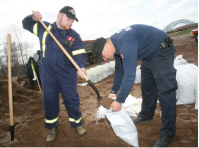 |
| Photo by Stephen MacGillivray, The Daily Gleaner Inset photo: Firefighters from the Upper Miramichi Fire Department and the Oromocto Fire Department prepare sandbags. |
Price gives NB EMO credit for being able to get some things done before the St. John River overflowed its banks.
“We met with NB EMO about a week and a half before the flood and they authorized certain expenditures for us, such as phone lines. It made it easier for me, since I knew I would be reimbursed for spending town money in the LSD [local service district] areas.” Phone lines were run into the command post on April 23, the day it was being set up, and the first day flooding began to affect the area.
Two satellite command posts were set up. The first was positioned at the Fredericton end of Route 105 near St. Mary’s and was manned by York Sunbury GSAR and EMO officials. This was a convenient location from which to issue residents their passes so they could return to check on their houses and farms if conditions were safe. A second satellite post became necessary to serve the Lincoln and Rusagonis-Wassis areas, which had not been affected by earlier floods. A trailer was provided by an RV dealer and was set up in the dealer’s parking lot near the Lincoln Big Stop Restaurant along the Trans-Canada Highway. This post, under the direction of New Maryland Fire Chief Harry Farrell, was staffed by the New Maryland Fire Department and members of the Tri-County GSAR team.
Price said there were more than 50 agencies involved during the two-week operation, including 25 surrounding fire departments. On April 26, the third day of operations, New Brunswick’s Department of Natural Resources offered its assistance and took over planning and logistics.
“This took a huge burden off of our shoulders as commanders,” Price said, “because besides organizing everything that needed to be done, we also had to deal with feeding everyone.” At the height of operations, 296 meals were served to emergency workers and volunteers at one sitting. Meals for evacuated residents were provided by the Red Cross at its evacuation centres.
The DNR planners prepared daily action plans, outlining the tasks and priorities that needed to be accomplished each day. These plans were distributed to the divisional supervisors in the field after an operations and safety briefing each morning. The safety briefings appear to have been helpful as only two minor injuries were reported among the hundreds of people who rotated through the area over the two weeks.
Some parts of Oromocto’s fire coverage area were either cut off by water, or were threatened by rising water, making normal access routes impassable. The Fredericton Fire Department deployed an engine company and crew to a community centre in the Maugerville area, north-east of Oromocto, while the New Maryland Fire Department to the west provided coverage to the Wassis area. Farrell was the site commander of the Lincoln command post. His firefighters drove through the area each day and reported their findings to the main command post at Burton to keep the incident commander up to date on the constantly changing conditions.
“We stopped to talk to the people and to check up on them,” Farrell said. “If they needed any assistance we either provided it or told them who to contact.”
Although power was disconnected from many homes, phone service was not affected. The Canadian Forces Base Gagetown Fire Department was on standby to back up the duty crew that was covering the Town of Oromocto from the main fire station in the town.
The Oromocto Fire Department went through a lot of consumables, most notably hand sanitizer and medical gloves. “The flood waters included material from sewerage lagoons, so every boat needed to have sanitizer on it,” said Price.
Life jackets were purchased from area stores to provide safety for those being removed from their homes by boat. Some of the boats used were for enforcement duties, and therefore had only enough life jackets on board for the crew. Price noted that finding child-sized life jackets was a problem. (Any items acquired for this incident that can be reused, will be cleaned, packaged and stored.) Meals were being ordered from local restaurants a week in advance to ensure restaurant workers had enough time to order in and prepare the food.
While every effort was made to encourage residents to evacuate before the water arrived, many chose to stay. Once these residents decided it was time to get out, they had to be rescued by boat, making the removal from their homes more of a challenge. “It appeared some people were looking for an adventure,” Price said, “but this placed a burden on us to remove them when conditions became unbearable, and was riskier to accomplish.”
A DND Bisson vehicle was used for one medical call but even it couldn’t navigate the higher waters later on. For possible medical calls, two boats were put on standby, with two Department of Fisheries members, two Oromocto firefighters and an RCMP officer.
With all the pre-planning, the Oromocto Fire Department still learned some lessons. Issuing passes to residents, while a valuable tool, was labour intensive and time consuming. The department will look at having the passes issued by more than one agency but recorded in a data-base that is accessible to all agencies that may need it. Communications between the command post and area residents is important, and was carried out on a regular basis to keep those affected up to date. Price noted, “The ICS system functioned excellent, and allowed over 50 different departments to work under one system, with one incident commander.
“Provincial DNR staff proved to be invaluable with their knowledge of ICS and large and long-term incidents.”
Price also learned that additional launch sites for boats need to be identified as rising waters compromised primary sites.
Price wanted to stress that a chief should never be ashamed to call on outside resources. The response to this natural disaster included 25 fire departments from as far away as the Moncton area, 175 kilometres east of Oromocto, and the Woodstock area, more than 100 kilometres northwest, well beyond the reach of normal mutual-aid response areas.
“We’re not scared to ask for help, whereas some areas may be reluctant,” he said.
Even as the department dealt with an abundance of water, things began to dry out, raising concerns of wildland fires.
Firefighters from the Moncton area were teamed up with an Oromocto firefighter to staff an engine company and did respond to a couple of calls.
Ironically, on the last day of operations for the flood, May 14, the Oromocto and area mutual-aid fire departments dealt with a large forest fire in the Lincoln area north of Oromocto.
Print this page